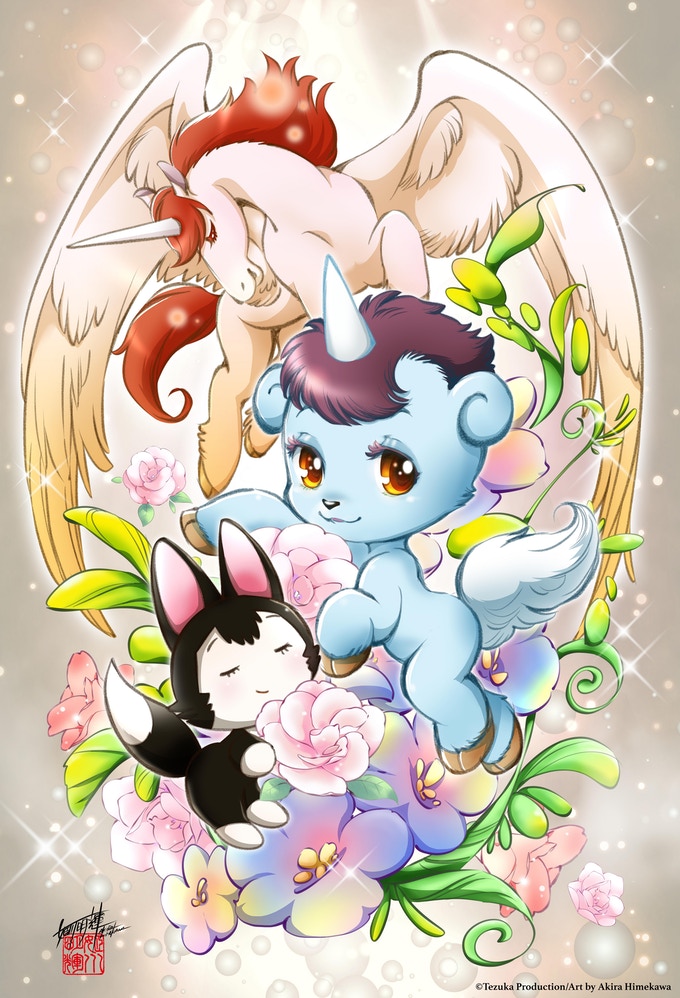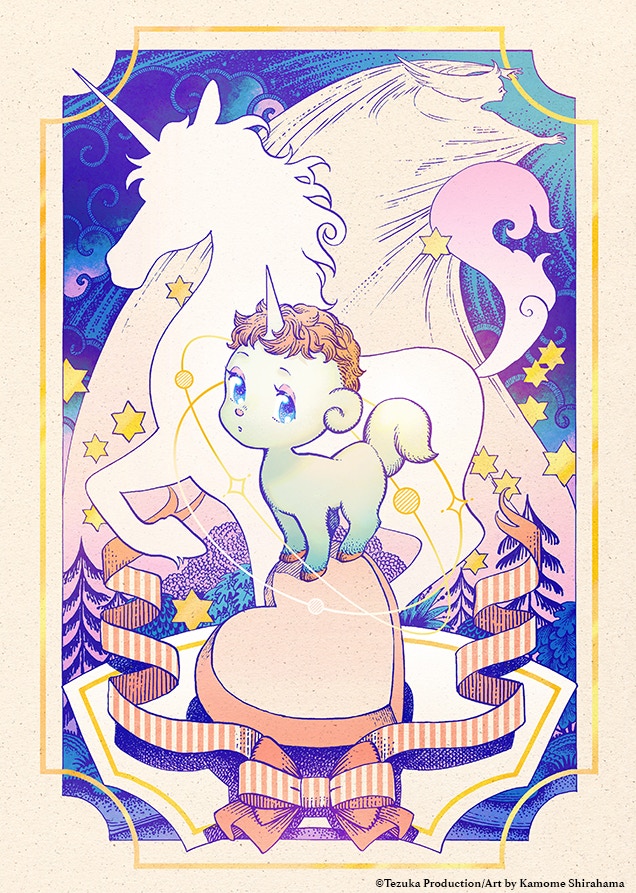The classic Osamu Tezuka manga Unico, originally published in Sanrio’s shojo manga magazine Lyrica in the 1970s, is being reimagined as a full-color manga titled UNICO: AWAKENING (ユニコ: 目覚めのおはなし)! The new 162-page manga launched on Kickstarter this week, and was fully funded within 24 hours, meaning anyone can back the project while it’s active to receive a copy of UNICO: AWAKENING when it’s published, in either English or Japanese! Plus, artists from around the world have come together to produce exclusive prints and limited edition collectibles from a picture book to a fashion lookbook.
The team behind the adaptation includes writer Samuel Sattin, behind the graphic novel adaptation of the Academy Award Nominated Cartoon Saloon film Wolfwalkers, and illustrator duo Gurihiru, known for their work in both American comics and Japanese games, manga and anime (notable works include Gwenpool and the upcoming Ultraman: Another Gene). They are working closely with Tezuka Productions in Japan to reimagine the classic “The Cat on the Broomstick” story from Tezuka’s original Unico manga.
As someone very interested in cross-cultural collaborations and adaptations of classic stories, this project intrigues me on so many levels! Luckily for me, I was able to correspond with Samuel Sattin about what it’s like to work with Tezuka Productions and Gurihiru, the differences between adapting a film to a graphic novel versus a manga to a manga/comic hybrid, and more.
Anne Lee: What was the impetus for this new adaptation of Unico? Is Unico a character you were previously familiar with?
Samuel Sattin: I was well familiar with Unico well before I got involved in the project, but I did learn far more about his story since then, which has been really edifying. I’ve been a big fan of Osamu Tezuka’s for a long while, and the possibility of engaging with his work left [me] gobsmacked. Of course I love Atom/Astro Boy (I have a pretty prominent tattoo from the Atom comics on my forearm), but what really solidified my love of Tezuka was reading his more adult—his gekiga—works. MW had a big impact on me, which I’d come to find out was created at the exact same time as Unico. This makes a strange kind of sense to me, as my impetus for wanting to work with Unico had to do with the character’s complexity and tragedy. Unico is a cute little unicorn, but his story is messy and meaningful. I’m drawn to its themes, and will try my best to engage with them.
Lee: Unico is an iconic Tezuka character, but I think the stories are lesser-known among English-speaking fans. What is it about Cat and the Brookstick that makes the story well-suited for a revival?
Sattin: It’s true that in the US especially there’s less familiarity with Unico–particularly the manga. But the films from the early-mid-eighties had more traction, which provides a little bit of awareness. The reason why I chose The Cat and the Broomstick arc is that it contains incredibly compelling themes revolving around identity, acceptance, and rage. There are some characters in it, including a cat that doesn’t want to be a cat, an elderly woman who’s lost her way, and a sadistic hunter with a hatred of the natural world. When I read and reread it, I feel like it has a lot to offer the modern world. I also think it poses a lot of questions that we can explore in the Unico universe, some of which many fans have asked over the years.
Lee: You’ve had experience adapting a work for graphic novel format before with Wolfwalkers. What are the similarities and/or differences between adapting a film to graphic novel versus an existing manga?
Sattin: Adapting WOLFWALKERS was an incredible experience, and I love working with the folks at Cartoon Saloon and Little Brown for Young Readers. The process of adapting a film to graphic novel format is more of a process of distillation, where you look for the best way to take an existing work and represent it accurately on the page; in the case of WOLFWALKERS, we’re talking about a matter of switching mediums, so the question is: how do we make this work as a comic? But with UNICO: AWAKENING, we’re doing a full reimagining of Tezuka’s project. We’re honoring both Tezuka and the project, while creating something new. With UNICO: AWAKENING you’ll discover that some characters take on larger roles than they did in the original work, and a larger story forms in the backdrop to further explore Unico’s world.
Lee: Can you speak at all about the process of writing the prologue and working with Tezuka Productions and Guruhiru Studios?
Sattin: Working with Gurihiru and Tezuka Production is one of the singular most amazing experiences of my life. I’ve been following Gurihiru’s work for a long time, before they won an Eisner for SUPERMAN SMASHES THE KLAN. In my eyes, besides being phenomenally talented, they have a unique ability to combine Japanese and Western comics art styles in a way that appeals to readers around the world.
The scripting phase for the prologue was interesting. First, I worked on an extended story treatment, which Deb Aoki did a great editorial pass on. Then, I went into writing the script itself, which I’m continuing [to] work on at the moment. I read and reread the opening pages of the original Unico, and made sure to convey that we were going to homage those pages, while setting up a new Unico universe. Both Gurihiru and Tezuka Productions reviewed the script, and save for some minor changes revolving around stray dogs (long story), we ended up progressing to translation. Aki Yanagi, who is Gurihiru’s representative and a great all-around comics professional, did all of that, and acted as a bridge for communication. In the process, we ended up moving forward rather quickly, and Gurihiru began sending character designs that just melted my heart to putty. It’s all been a genuinely enthusiastic and forward-moving experience.
Lee: Unico: Awakening is billed as a manga, and of course the original Tezuka work is a classic girls’ manga, but Guruhiru has extensive experience working in American comics in addition to their work in Japan. After reading the prologue, influences from both Japan and western comic traditions are apparent. Do you feel this is something that occurs naturally in the adaptation process? Does the context of publishing this work as a manga affect your process of writing the script? (As opposed to something like WOLFWALKERS that you adapted as a graphic novel.)
Sattin: This is a great question, thank you for asking it. For all of us working on this project, one of the main goals is to make UNICO: AWAKENING a genuinely collaborative project in terms of its appeal. Part of what’s so important about homaging Osamu Tezuka is that we honor his vision of comics being an international language. He truly [believed] that comics could be a form of Esperanto, and he believed in the idea of sharing ideas cross-culturally and creatively. For this reason, one of the goals of this project is to make something that isn’t relegated to a certain, set sensibility. Gurihiru’s art is perfect for this, since it does indeed blend Japanese and Western influences in ways that have allowed them to find success internationally. As a writer who really loves manga, western comics, and prose from all over the world, I have committed to working with everyone involved in UNICO: AWAKENING to ensure that we accomplish these goals to the best of my ability.
Lee: What are you most excited about for the Unico Kickstarter?
Sattin: Oh, I don’t believe I can limit my excitement to one thing! I’m excited about our book, of course. But really, I’m just excited by the way in which people are reacting to the project, and the amazing artists who have contributed prints and items we’re referring to as Artifacts. There’s so much beautiful work to get your hands on, and I hope to see Unico prints by Kamome Shirahama, Junko Mizuno, Akira Himekawa, Tomm Moore, Katie Longua, Soo Lee, and Peach Momoko hanging on walls around the world.
Thank you Samuel for taking the time to answer my questions! To receive a copy of UNICO: AWAKENING when it’s completed and get your hands on some of the exclusive rewards mentioned above, check out the Kickstarter before it ends on June 3rd.



